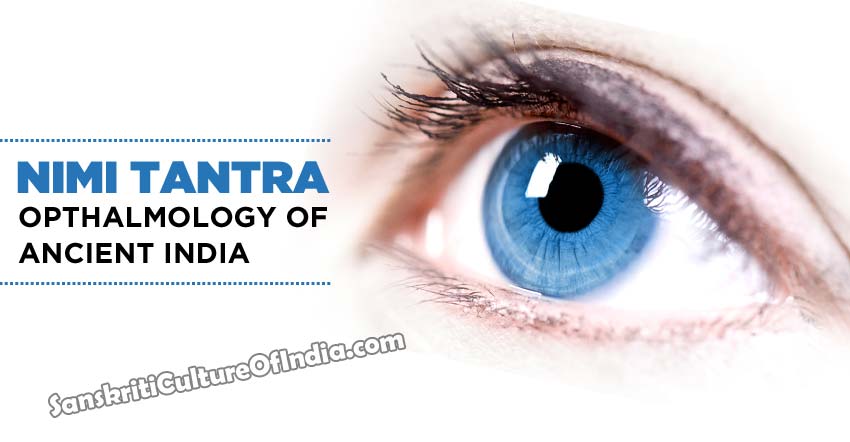The art of ophthalmology was well developed in ancient India and was known as Nimi Tantra. The article below presents main features of Nimi Tantra an authoritative treatises written by Nimi, a prominent ophthalmologist of his time.
Of all the ancient medicines, the Indian is undoubtedly of intrinsic merit and of historic value especially as a source for the study of the evolution of the subject. The earliest period being much older than that of Greek Medicine, presents a more primitive form of medical speculation and therefore gives a clearer picture of the development of medical ideas. Max Neuburger introduces his study The Medicine of the Indians with the remark: “The medicine of the Indians, if it does not equal the best achievements of their race, at least nearly approached them, and owing to the wealth of knowledge, depth of speculation and systematic construction takes an outstanding position in the history of oriental medicine”.
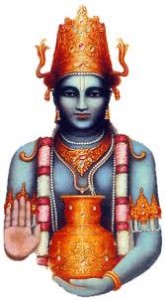 Tradition traces the genesis of medicines from a mythical, a semi-mythical to a historical beginning. According to this tradition, the God Indra taught the science of medicine to Atreya, and the science of surgery to Dhanwantari Divodasa. Dhanwantari taught the subject to twelve of his pupils. To seven of them he taught special surgery (Salya Tantra). Special surgery and medical treatment of the parts of the body above the clavicle, including the ear, eye, mouth, nose etc. (Salakya Tantra) he taught to five others – Nimi, Bhoja, Kankayana, Gargya and Galava.
Tradition traces the genesis of medicines from a mythical, a semi-mythical to a historical beginning. According to this tradition, the God Indra taught the science of medicine to Atreya, and the science of surgery to Dhanwantari Divodasa. Dhanwantari taught the subject to twelve of his pupils. To seven of them he taught special surgery (Salya Tantra). Special surgery and medical treatment of the parts of the body above the clavicle, including the ear, eye, mouth, nose etc. (Salakya Tantra) he taught to five others – Nimi, Bhoja, Kankayana, Gargya and Galava.
Ophthalmology was a recognised branch of Salakya tantra and we owe our fullest treatment of it to the Uttara tantra of Susruta. Its history goes back to a period of very remote antiquity. The author of the Uttara tantra, in his introduction, specially observes: “This part comprises within it the specific descriptions of a large and varied list of diseases viz., those which form the subject matter of the Salakya tantra diseases of the eye, ear, nose and throat – as narrated by the kind of Videha”. The Salakya tantra here referred to must be that traditionally credited to Nimi, the King of Videha (present day Uttar Pradesh), the reputed founder of the Science of Ophthalmology in India.
Undoubtedly the most proficient and prominent surgeon of his time Nimi worked upon many treatises all exclusively and exhaustively dealing with the surgery and treatment of the eye and its diseases. Unfortunately, though the contents of these tantras were, in a compressed and selective form, compiled in Susruta’s Compendium, the original of the work is not now available. The names of other famous works by Nimi are said to be Vaidya Sandehabhanjini and Janaka tantra. About this period six other Salakaya tantras written by the disciples of Nimi Salyaka, Saunka, Karalabhatta, Caksu Sena, Videha and Krsnatreya appear to have been current and regarded with great esteem.
Though the identity of Nimi is still a question of keen debate, we have reliable records to assume that he was the great grand-father of Sita, the daughter of Kind Janaka. He is believed to have been the twelfth King in descent from the Iksvaku line of kings who then ruled the kingdom of Ayodhya. He claimed equal recognition in other reputed titles like Videha, Videhaldipa, Mahavideha, Janaka and Rajarsi. A very strange and striking parable lives in our ancient mythology that goes to illustrate the grandeur and magnanimity of Nimi’s devotion to his profession, and his services as an eye physician. He was once alleged to have picked a quarrel with the great sage Vasistha during the performance of a religious ceremony and the Rishi, with a strong emotion excited by moral injury, invoked curse upon him. Nimi strongly pleaded for pardon. As a result he earned a precatory power by means of which he was allowed to reside invisible in the eyes of men. In Tulasidasa Ramayana we come across references that supplement the belief that Nimi was the ‘eye of the eyes’. Struck by surprise and admiration at the marvelous performance of Sree Rama’s cracking the mighty bow when Sita Rama’s cracking the mighty bow when Sita stared at him, the courtiers were said to have let out a cry of wonder, at a loss to know to where Nimi had disappeared from her eyes.
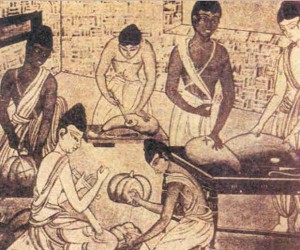 Nowhere it is recorded in the history of medicine that we had arrangements in India for making artificial eyes. From some medical texts of Egypt we find that the Egyptians had early acquired a name for finishing artificial eyes under a very orderly system from a date after 500 B.C. The eyes were made by way of filling the orbital cavity with method wax and fixing sapphires in place of the Iris. The deep pure blue tint of the stones added new glow and glamour to the eyes. In India as a suitable remedy for weak sight spectacles were widely adopted, from a time very far back approximately 1000 years ago. To the Chinese goes the entire credit for the initiative in the invention of spectacles. Some time in the twelfth century, in Mongolia, the Venetian traveler Marco Polo was seen reading with spectacles at the court of the great King Kublai Khan.
Nowhere it is recorded in the history of medicine that we had arrangements in India for making artificial eyes. From some medical texts of Egypt we find that the Egyptians had early acquired a name for finishing artificial eyes under a very orderly system from a date after 500 B.C. The eyes were made by way of filling the orbital cavity with method wax and fixing sapphires in place of the Iris. The deep pure blue tint of the stones added new glow and glamour to the eyes. In India as a suitable remedy for weak sight spectacles were widely adopted, from a time very far back approximately 1000 years ago. To the Chinese goes the entire credit for the initiative in the invention of spectacles. Some time in the twelfth century, in Mongolia, the Venetian traveler Marco Polo was seen reading with spectacles at the court of the great King Kublai Khan.
Nimi’s tantra contains a lucid presentation of the gross anatomy of the eye, of almost all the diseases and of all the medicines administered with special references to surgery. The order in which this work is said to have treated the important diseases along with their causes, symptoms and complications, has been a standard to all subsequent writers. It is one of the most popular works on Indian medicine.
The eye-ball is described as two fingers’ broad, a thumb’s width deep and two and a half fingers in circumference. The eye, we are told, is almost round in shape and is made up of five mandalas, or circles, six sandhis or joints, and six patalas or coverings.
The mandals are:
- Paksma (circles of the eyelashes)
- Vartma (circles of the eyelids)
- Sveta (the white circle)
- Krishna (region of the cornea)
- Drishti (circles of the pupil).
The sandhis are:
- Pakshmavartma (between the eye – lashes and eyelids)
- Vartma sveta (the fornise)
- Sveta krishna (the limbus)
- Krishna drishti (the margin of the pupil)
- Kaninika (the inner canthus)
- Apanga (the outer canthus)
Of the six patalas two are in the eyelid region and four are in the eye proper. There are two marmas near the eye, apanga at the outer end of the eyebrow and avarta above the middle of the eyebrow. If these are cut, loss of sight results.
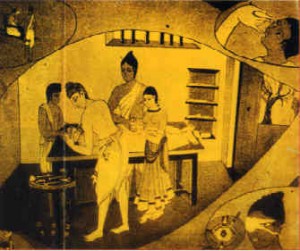 Most of the common diseases of the eye were known to Nimi. He gives an count of 76 eye diseases of which ten are due to vata dosha, ten to pitta dosha, thirteen to kapha dosa and sixteen to vitiated blood, twenty five are caused by the united action of the three doshas (sannipatha) and two are due to external causes (visible or invisible injury) cloudiness of vision, lachrymation, slight inflammation, accumulation or secretion, heaviness and burining sensation, racking or aching pain, redness of eye are indistinctly evident as premonitory symptoms.
Most of the common diseases of the eye were known to Nimi. He gives an count of 76 eye diseases of which ten are due to vata dosha, ten to pitta dosha, thirteen to kapha dosa and sixteen to vitiated blood, twenty five are caused by the united action of the three doshas (sannipatha) and two are due to external causes (visible or invisible injury) cloudiness of vision, lachrymation, slight inflammation, accumulation or secretion, heaviness and burining sensation, racking or aching pain, redness of eye are indistinctly evident as premonitory symptoms.
As to the location of diseases nine are confined to the sandhi, twenty one to the eyelids, eleven to the sclera, four to the cornea, seventeen to the entire eye-ball, twelve to drishti. Two, though referring to drishti, are due to external causes and are very painful and incurable. It is not possible however to identify everyone of the seventy six diseases he describes. K. S. Mhaskar in his ‘Opthalmology of the Ayurvedists’ identified many of those diseases and has indicated the nearest Western equivalents for the Ayurvedic terminology.
Suppurative dacrocystitis is named puyalasa, phlectenular conjunctivitis and blephartis due to pediculi pubis, and capitis are referred to as krimi grandhi. Chronic blepharospasm is nimisha. The name for cysts, polypi, fatty tumors, in arbuda, a style is known as kumbhipidaka. Pothaki, a form of granular conjunctivitis, is also described. The description is suggestive of trachoma. Under the name of abhishyanda four varieties of catarryhal conjunctivitis are explained. These, if left untreated become mucopurulent and then orbital cellulitis sets in. Under the group of the disease of the sclera, many varieties of pterygim are narrated – sirajala (pannus) sirapidika (scleritis),suktika (xeropthalmia) and arjuna (sub-conjunctival ecchymosis). The names given to acute keratitis is sira-sukra, to ornea ulcer savrana sukra; to nebulae vrana sukra, to hypopyon ulcer pakatyay; and to anterior staphyloaa, ajaka. In the group of the diseases of the vision, two kinds of night blindness are mentioned (Nakulandha and Hrasvajandha); glaucoma and retinitis are also mentioned (Dhumra and Amalandha). Complete lingadosa causes loss of vision and incomplete lingadosa admits of faint perception of brilliant objects like the sun, moon, stars and flashes of lighting etc. The complaint has three preliminary progressive stages of defective vision called timira.
Of the seventy six kinds of diseases eleven should be treated with incision operations (chedya); nine with scarification (lekhya); five with excision (bhedya); fifteen with venesction (siravedhya); twelve should not be operated upon, and nine admit only of palliative measures (yapya) while fifteen should be given up as incurable. Opthalmoplegia, nyctalopia, hemeralopia, glaucoma, keratitis and corneal ulcers, subconjunctival echymosis, scleral nodules, blepharitis, xerothalmia membraneous conjunctivitis and sclerosis are diseases in which operation is not indicated.
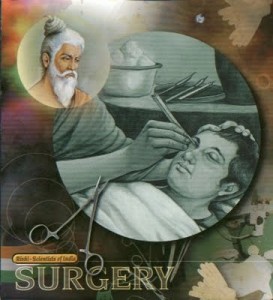 It was Nimi who first gave instructions for operation on a cataract. The privilege is ours that it was first performed in India. This operation attracted attention from all quarters of the world. We come across a translation of the description of the whole procedure of the operation in Jolly James` Indian Medicine. It runs that : “In moderate temperature the surgeon should himself sit in the morning in a bright place on a bench which is as high as his knee, opposite the patient who is sitting fastened on the ground at a lower level and who has bathed and eaten. After warming the eye of the patient with breeze of his mouth and rubbing it with the thumb and after perceiving impurity in the pupil (lens) he takes the lancet in his hand while the patient looks at his own nose and his head is held firm. He inserts it in the natural opening on the side, ½ finger far from the black and ¼ finger from the external eye-corner and moves it upwards to and fro. He pierces the left eye with the right hand and the right eye with the left. If he has pierced rightly there comes a noise and a water drop flows out without pain. While encouraging the patient, he moistens the eye witfi women’s milk and scratches the eye apple with the edge of the lancet without causing pain. He then pushes the phlegm in the eye apple gradually towards the nose. If the patient can now see the objects (shown to him) then the surgeon should pull out the lancet slowly, should place greased cotton on the wound and let the patient lie down with fastened eye”.
It was Nimi who first gave instructions for operation on a cataract. The privilege is ours that it was first performed in India. This operation attracted attention from all quarters of the world. We come across a translation of the description of the whole procedure of the operation in Jolly James` Indian Medicine. It runs that : “In moderate temperature the surgeon should himself sit in the morning in a bright place on a bench which is as high as his knee, opposite the patient who is sitting fastened on the ground at a lower level and who has bathed and eaten. After warming the eye of the patient with breeze of his mouth and rubbing it with the thumb and after perceiving impurity in the pupil (lens) he takes the lancet in his hand while the patient looks at his own nose and his head is held firm. He inserts it in the natural opening on the side, ½ finger far from the black and ¼ finger from the external eye-corner and moves it upwards to and fro. He pierces the left eye with the right hand and the right eye with the left. If he has pierced rightly there comes a noise and a water drop flows out without pain. While encouraging the patient, he moistens the eye witfi women’s milk and scratches the eye apple with the edge of the lancet without causing pain. He then pushes the phlegm in the eye apple gradually towards the nose. If the patient can now see the objects (shown to him) then the surgeon should pull out the lancet slowly, should place greased cotton on the wound and let the patient lie down with fastened eye”.
Besides this surgical treatment, a variety of other methods with medicines were in practice to cure cataract. One of the most curious methods adopted by the physicians of the time is quite interesting to go through. A fully developed dead cobra was put into a jar of milk along with four scorpions, and was kept aside to degenerate and decay in the milk for about a period of 21 days. After that the milk was churned into butter. This butter was fed to a cock. The fecal matter of this cock was applied to the eye by which the very last vestige of cataract was wrung out of the eyes.
“Without what we call our debt to Greece we should have neither one religion, nor one philosophy, nor one science nor literature nor one education nor politics”, writes Dean Inge in his Legacy of Greece. Hellenism is every thing to Western civilization but whether it had any influence on Eastern Civilization is very doubtful and remains to be proved. The possibility of a dependence upon the other cannot be denied when we know, as a historical fact, that two Greek physicians, Ktesias and Megasthenes, visited and resided in northern India. A study of the Samhitas of Caraka and Susruta reveal many analogies between the Indian and Greek systems of medicine. It is true, celebrated branch of medicine (Ophthalmology) also penetrated into the neighboring countries like Greece and Baghdad, and took startling strides in the hands of their efficient physicians. Many works on Ophthalmology were translated into Arabic under the keen patronage of the rulers and scientists. Through the dexterous instruction of the learned, and their intense research and experiments, Opthalmology acquired new depth and width, and very striking growth in Baghdad. After this golden age, for a moderately long space of time, there was a lull in this branch of medicine until a much later date when it received a new impetus under the patronage of modern scientists.
~ C.K. Ramachandran

